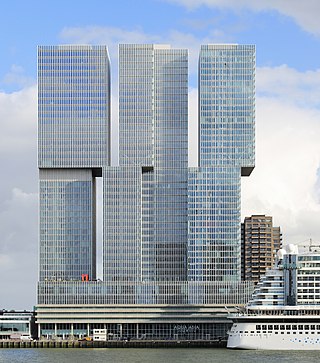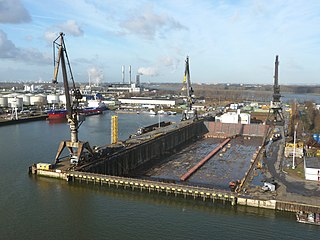
The Poortgebouw is a national monument located at Stieltjesstraat 38 in the Kop van Zuid area of Rotterdam, the Netherlands. It was built beside the River Maas in 1879 and experienced a range of uses until it was squatted 3 October 1980. It had been standing empty for 2 years and was squatted as a protest intended to highlight the lack of affordable residential housing in Rotterdam.

XerxesDZB is a Dutch football club based in Rotterdam.

Pieter Abramsen was a Dutch sculptor, and visiting professor at the Delft University of Technology, known for his work in which abstraction and realism are joined.

De Rotterdam is a building on the Wilhelminapier in Rotterdam, designed by the Office for Metropolitan Architecture in 1998. The complex is located between the KPN Tower and Rotterdam Cruise Terminal and was finalized at the end of 2013. On 21 November 2013, the municipality of Rotterdam, as the largest user, received the keys. The design provides space for offices, a hotel and apartments. The 44 floors amount to a total floor space area of about 160,000 m², making it the largest building in the Netherlands.

Dora Dolz de Herman was a Spanish-Dutch artist, best known for her outdoor ceramic works in the form of chairs and sofas.
Teunis (Teun) Jacob was a Dutch wall painter and sculptor, who lived and worked in Rotterdam since the early 1950s. He made both figure and nonrepresentational art.
Daniël (Daan) van Golden was a Dutch artist, who has been active as a painter, photographer, collagist, installation artist, wall painter and graphic artist. He is known for his meticulous paintings of motives and details of everyday life and every day images.
The Hendrik Chabot Award is an annual award for visual artists presented by the Prins Bernhard Cultuurfonds, section South Holland. The prize ceremony is in the city hall of Rotterdam, where the prize is given by The Mayor of Rotterdam and the King's Commissioner in the province. The reward is named after the Rotterdam artist Hendrik Chabot.

Voetbalvereniging Smitshoek is a football club based in Barendrecht, South Holland, Netherlands. Founded in 1960, they are currently members of the Vierde Divisie, the fifth tier of the Dutch football league system. They play their home matches at Sportpark Smitshoek.

Damen Verolme Rotterdam, is a repair shipyard in Rotterdam, Netherlands.

Vrijplaats Koppenhinksteeg was a complex of buildings first squatted in 1968 in Leiden, the Netherlands. It took its name from the alley on which it was located and was run since the 1990s by the Vrijplaats Koppenhinksteeg Foundation. Various groups including Eurodusnie used the different spaces as a bar, café, a freeshop, a foundation to support undocumented migrants, an information centre, a library and a sports club. In 2010, the entire complex was evicted. From 2012 onwards a new space called the Vrijplaats Leiden was set up elsewhere.

We Are Here is a collective of migrants based in Amsterdam, the Netherlands, which campaigns for human rights for its members and all undocumented migrants. The asylum seekers have in many cases had their applications to remain in the Netherlands denied but they either cannot go back or refuse to return to their country of origin. They demand access to social services such as medical care and housing. The group formed in 2012 and by 2015 contained over 200 migrants from around 15 countries.
The WNC squat was a self-managed social centre in Groningen, the Netherlands. It was squatted in 1985 and evicted in 1990.

Squatting in the Netherlands is the occupation of unused or derelict buildings or land without the permission of the owner. The modern squatters movement began in the 1960s in the Netherlands. By the 1980s, it had become a powerful anarchist social movement which regularly came into conflict with the state, particularly in Amsterdam with the Vondelstraat and coronation riots.

Hendrik Everhart (Henk) Tas is a Dutch visual artist, working as a sculptor, photographer, graphic artist, and wall painter.

De Vloek was a squatted, self-managed social centre in The Hague, the Netherlands, between 2002 and 2015. Located on Hellingweg 127 in Scheveningen, beside the North Sea, the squat hosted workplaces, living spaces, a venue, and a vegan restaurant. The local council tolerated the occupation until 2014, when it decided to sell the building. A political struggle over the eviction began; some political parties supported the squatters and the Scheveningen Pier was briefly occupied as a protest action. A deal was made for the squatters to move to a former school building and the Vloek was eventually evicted in September 2015.

Janine Wegman was a Dutch Hammond-organist and artist based in Rotterdam. She was one of the first Dutch people to be openly transsexual.
Op de Valreep was a squatted building in Amsterdam, the Netherlands. Occupied in 2011, the former animal shelter was converted into a self-managed social centre. The squatters resisted eviction with creative actions, such as pretending the council had given them ownership and making spoof election materials. They were forcibly removed in 2014; the building was later converted into a restaurant.

The Wyers squat was a self-managed social centre on Nieuwezijds Voorburgwal in central Amsterdam, the Netherlands, between 1981 and 1984. The buildings of the Wyers former wholesale textile company were converted by the squatters into a range of living and work spaces. When the Government of Amsterdam decided to demolish the complex to make way for a Holiday Inn hotel, a car parking garage and apartments, the squatters made alternative proposals. The eviction was announced for February 14 1984 and there were demonstrations in support of the squat around the country. On the day of eviction, 1,500 people stayed inside the building then left without conflict. The breeding place discourse of new cultural initiatives presented by the squatters was later adopted by the city council.















